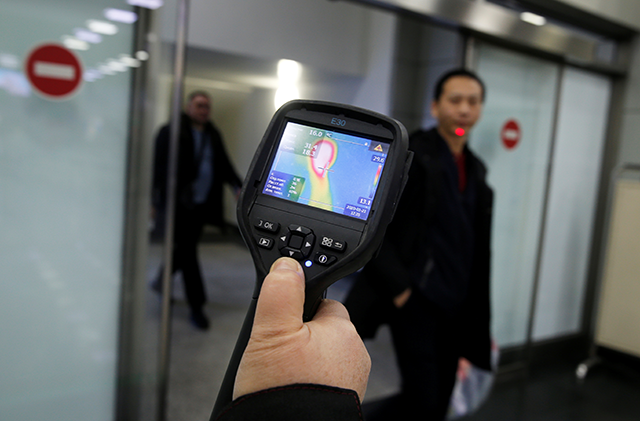On Tuesday, the Centers for Disease Control and Prevention officials announced the first known U.S. case of a new strain of coronavirus that has killed at least 17 people and sickened hundreds in China.
A Washington state resident who recently traveled home from near where the virus broke out in Wuhan, China, is the first U.S. patient.
[raw]
Read more of MinnPost’s COVID-19 coverage
[/raw]
While the fact that the virus is on U.S. soil isn’t necessarily good news, it’s no reason to panic, said Michael Osterholm, the director of the Center for Infectious Disease Research and Policy at the University of Minnesota.
So before visions of the movie “Outbreak” dance in your heads, here’s what we know — and don’t know — about the virus so far.
I just got back from a long weekend. Give me some background.
The virus is a new strain of coronavirus identified in Wuhan, China, in December. The outbreak is believed to have begun in a market there, where a human may have picked up the virus from an animal. But now, health officials say the virus has gone beyond transmitting only from animals to humans and is now spreading between humans.
“It’s clear we’re well beyond the stage of worrying about animal to human transmission causing a problem. It’s now human to human,” Osterholm said. Most of the known cases are concentrated in China, with a few cases in other parts of Asia.
OK, so what is this new virus?
Like any virus, coronavirus infects the cells of its hosts and uses them to help it replicate and infect other hosts.
While this strain is new, coronaviruses aren’t. Recent notable coronaviruses include SARS (Severe Acute Respiratory Syndrome), which broke out in China in 2002, and MERS (Middle East Respiratory Syndrome), which broke out in Saudi Arabia in 2012.

[image_credit]CDC[/image_credit][image_caption]The outbreak is believed to have begun in a market in Wuhan, China.[/image_caption]
If you look at the virus up very very close, the spikes that surround the circular virus look like a crown.
What kind of animal is this new strain from?
It’s too early to tell. SARS jumped from animals to humans through palm civets, which are small, cat-like carnivores. MERS jumped from camels to humans.
What happens next?
Osterholm says we can expect to see global transmission of the virus now that it’s going from human to human. But it’s not yet clear just how transmissible the virus is.
There are basically two options, Osterholm said: One is it’s regular transmission, where someone might be infectious enough to infect between one and three people who are close colleagues, friends or family members.
“That means the outbreak tends to move more slowly,” Osterholm said: It’s easier to identify them and isolate infected people so they don’t transmit it to others.
But if it’s a fast-spreading virus, called a “super-spreader,” it can move much more quickly. Such was the case in the early 2000s SARS outbreak: A physician who had become infected with SARS stayed at a hotel in Hong Kong for a wedding. Many people who had only so much as stood in an elevator with him or stayed in the room next door came down with the virus, and some of them took it back home with them, Osterholm said.

[image_credit]Wikimedia commons[/image_credit][image_caption]An example of a coronavirus.[/image_caption]
The magnitude of outbreaks could have to do with which animal it comes from. When palm civets were discovered to be transmitting SARS they were taken out of markets, turning off the supply of new virus and leaving health officials to deal with just human to human contact, Osterholm said. In the case of MERS, well, there are 14 million camels in the world, and many of them have contact with humans.
“Nobody’s going to exterminate 14 million camels,” Osterholm said. MERS outbreaks continue on the Arabian peninsula.
Is there a potential for a pandemic?
No. A pandemic, by definition, is a global epidemic. The only infectious agent capable of causing a pandemic is a novel strain of flu, Osterholm said.
“I would never refer to coronavirus as a pandemic agent,” Osterholm said. Rather, it’s likely to cause significant outbreaks in some areas.
What are the symptoms?
That’s not clear yet. Some cases have been pretty mild, and some have been deadly. Osterholm said officials are collecting information like date of onset, progression, symptoms, ages affected and severity, and that should help outline symptoms.
Should I be worried?
“Right now my biggest concern in terms of direct impact on the U.S. is not what it’s going to do to our health with the virus being here,” Osterholm said. The U.S. has never really had an outbreak of SARS or MERS, and Osterholm is more worried that China, which supplies much of the U.S.’ drugs and medical products, could be sufficiently sickened by the new virus strain to shut down manufacturing or transportation of all sorts of medical products the U.S. uses every day.






“Osterholm is more worried that China, which supplies much of the U.S.’ drugs and medical products, could be sufficiently sickened by the new virus strain to shut down manufacturing or transportation of all sorts of medical products the U.S. uses every day.”
I wasn’t alarmed by this virus. Nor am I after reading this. But every American should be at least a little alarmed about this information.
Sounds like the U.S is ready to sever ties with china. GINEUS WAY OF DOING IT. PLANT AN OUT BREAK. I wouldn’t be surprised if we sent some inefficient with a virus to China. (Sabotage) our trade agreements.
F.y.i I know I missed spelled words but I’m sure your know why and in sure you can figure out the context of what I’m trying to say
Truth! I have no worries at all. I am more than tired of the corporate fear mongering.